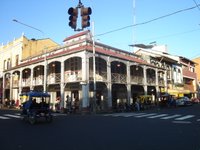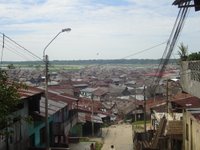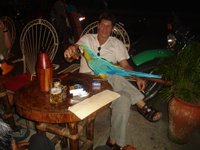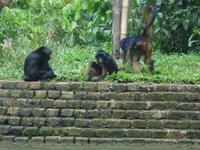
Our initial exploration of the Iquitos led us to The Yellow Rose of Texas. It is located just off of the Paza de Armas on Putumayo street (towards the river). The place is run by an ex-oil and gas engineer named Gerald Mayeaux and the place is overflowing with character. The bar stools are saddles and there is so much stuff on the walls and hanging from the ceiling that it is hard to take it all in. There are a wide variety of dead jungle animals, native artifacts, and thousands of pictures.
While the decoration is completely over the top, it is still not the greatest contributor to the place's character. That award goes to the larger than life personalities of the regular patrons. They can best be described as overweight, middle-aged, ex-patriots from the US, UK, and Oz who have taken up residence in Iquitos because they can live like kings. They all have an opinion about absolutely everything and are more than willing to discuss/argue any point you could possibly bring up.
One guy showed up the night we were there with a giant blue parrot. The guy promptly order two beers, one for himself and the other for the bird. The bird drank right out of the mug. By the end of the night both the guy and the bird were falling out/off of the chair. The bird would slide down the curved back rest of the chair and then have to pull itself back up to the top using its beak.
 We also went out to Quistococha, Iquitos' zoo. This was a major stop on the tour for us because Quistococha is a partner zoo with the Perth Zoo where Rebecca works. One of her friends has spent a lot of time in Iquitos working at the zoo and we wanted to see everything that he had done. The zoo has spider monkeys, cougars, jaguars, black jaguars, tons of monkeys, and even Bruno's older bigger cousins.
We also went out to Quistococha, Iquitos' zoo. This was a major stop on the tour for us because Quistococha is a partner zoo with the Perth Zoo where Rebecca works. One of her friends has spent a lot of time in Iquitos working at the zoo and we wanted to see everything that he had done. The zoo has spider monkeys, cougars, jaguars, black jaguars, tons of monkeys, and even Bruno's older bigger cousins. We also went out to Belen, a section of Iquitos that played host to the movie Fitzcarraldo. About 10% of Belen is built on the shore and about 20% is built on stilts over the river and can be accessed by bridges and catwalks. The remaining 70% is comprised of floating buildings that extend out into the river. Everything that a normal city on land has can be found here. Schools, churches, stores, homes, etc...
We also went out to Belen, a section of Iquitos that played host to the movie Fitzcarraldo. About 10% of Belen is built on the shore and about 20% is built on stilts over the river and can be accessed by bridges and catwalks. The remaining 70% is comprised of floating buildings that extend out into the river. Everything that a normal city on land has can be found here. Schools, churches, stores, homes, etc...



3 comments:
Hey, O - I am fascinated by places that are built partly on land and partly on water. Most of the small towns on the BC and SE Alaska coast began with buildings on pilings - the layers of things that get built over time is pretty interesting.
And the parrot sliding off the chair - very wonderful image!
it's funny that the city is not connected to other cities. Living in America, it's hard to imagine that. Anyway, looks like a fun city to explore :)
I am glad that you guys liked this post.
Post a Comment